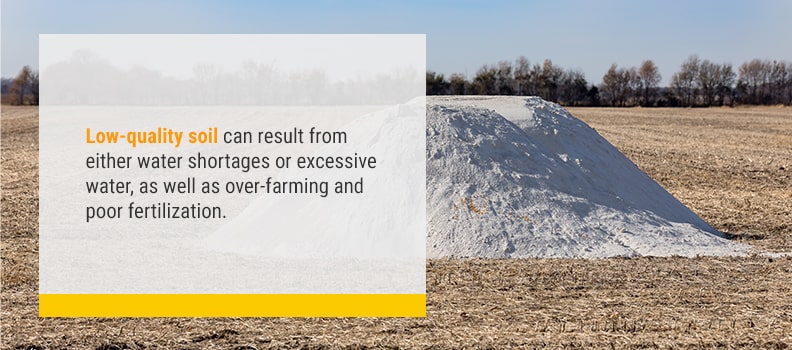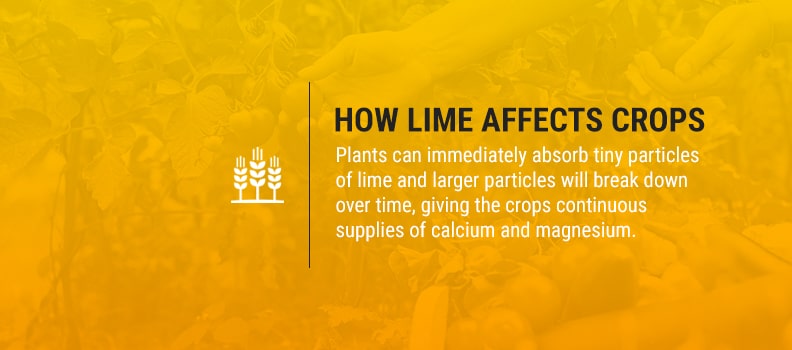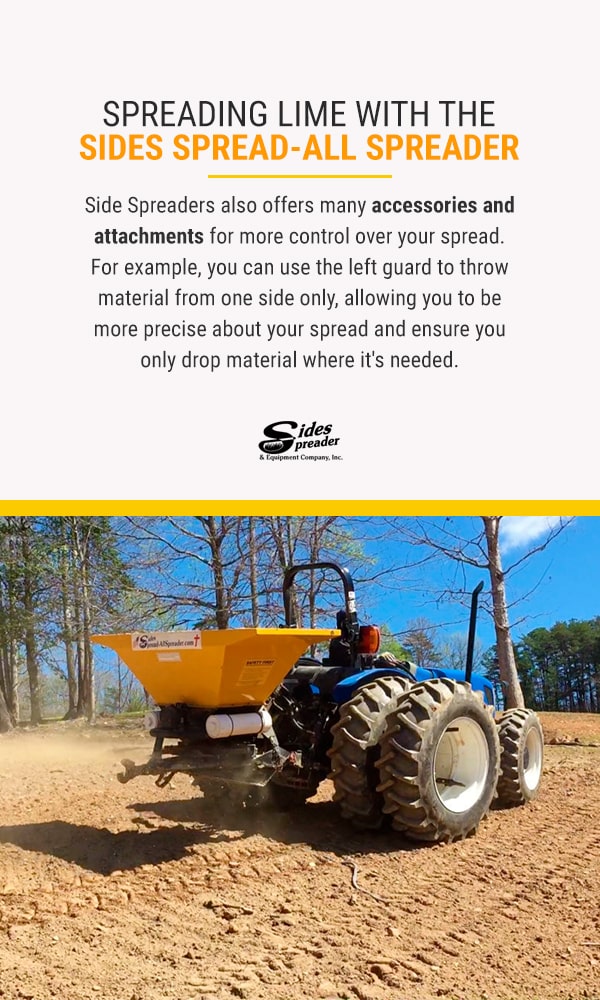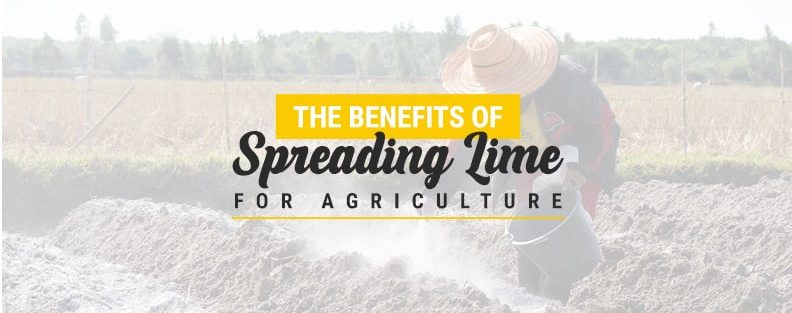The minerals and nutrients plants need to thrive are scarcer in areas where the soil is acidic. Plants in these areas often struggle to survive and produce crops. To have a plentiful yield, you may need to lime your land and follow it with fertilizer.
Fertilizer is essential for healthy plant life and bountiful yields, replacing the potassium, phosphorous and nitrogen necessary for crops to survive. You can also expect greater water retention with fertilizer that adds boron, copper, iron, magnesium, calcium and sulfur. Combining these nutrients will promote thicker and healthier plant growth at a faster rate.
However, using fertilizer on your plants will only waste materials if you have acidic soil, which is where the use of agricultural lime becomes essential.
Spreading lime will balance your soil’s pH level and fertilizer will continue to give your plants the nutrients they need. You cannot use one in place of the other and you should expect to use both resources.
Types of Agricultural Lime
You have two main types of agricultural lime to choose from:
- Wet lime: Because this crushed limestone comes in fragments of various sizes, some pieces will dissolve much more quickly than others. To apply wet lime evenly, you need a special spreader like the Sides Spread-All Spreader.
- Pelletized lime: You can spread pelletized lime evenly much quicker and mix it with other fertilizers. As it’s much easier to handle and disperse and compatible with more spreaders, it tends to be the most used form of lime. It is, however, more expensive than wet agricultural lime.
You can apply agricultural lime to lower soil acidity with calcium or magnesium additives when it’s in one of these forms:
- Carbonate: Calcium carbonate is the main component of limestone, and ground limestone is the most commonly used form of agricultural lime.
- Hydroxides: Calcium hydroxide, often called slaked or hydrated lime, is a liquid mixture of agricultural lime and water.
- Oxides: Calcium oxide, also known as quicklime, is the fastest-acting and most neutralizing form of agricultural lime. It’s more hazardous and challenging to handle than other types.

What Are the Benefits of Liming?
Soil quality affects the outcome of a harvest. High-quality soil will be able to suppress weeds and pests and hold the nutrients and water that plant roots need to absorb for them to thrive. This soil is also free of toxins that harm plants, has a sufficient supply of nutrients and promotes a significant presence of organisms that encourage crop growth.
Low-quality soil can result from either water shortages or excessive water, as well as over-farming and poor fertilization. Your soil’s pH level is a tell-tale sign of its quality. Acidic soil prevents the nutrients crops need and can cause unwanted results such as weeds, disease and pests. Fixing low-quality soil can be a challenging and lengthy process.
Agricultural lime is a soil conditioner that neutralizes acidic soils. Lime raises soil pH levels as it dissolves, providing greater nutrient solubility and enabling earthworms and micro-organisms to thrive. If your soil has high levels of toxic elements like iron, manganese and aluminum, a higher pH level will keep them in a solid state so plants can’t absorb them.
The many benefits of agricultural lime include:
- Increased microbial activity: The microbes that aid in plant survival require specific environmental conditions. Lime promotes a healthy environment for them to thrive.
- Strengthened root system: Balanced soil allows for more nutrient uptake, making the root system more robust and better able to withstand wind, draughts and rain.
- Improved plant structure: Plants can grow stronger in balanced soil. As the roots grow stronger, the additional strength works from the root up and allows the crops to yield more product.
- Promoted fertilizer efficiency: Fertilizers and herbicides function best in balanced soil, giving you the greatest return for your time, money and effort.
- Increased nutrient uptake: Plants can more easily find the food they need in balanced soil. Soil with a balanced pH increases nutrient availability, making it easier for plants to absorb them.
- Promoted mineral intake: Lime provides magnesium, calcium and other minerals needed by plants and crops to thrive.
- Increased return on investment: One application of lime can last for several years. Because balanced soil promotes a better yield, you can see a more significant return on investment after a single application.

How Lime Affects Crops
While some plants produce well in acidic soils, most plants thrive in a pH-neutral environment and benefit immensely from liming. Balancing your soil’s pH will let them more efficiently take up nutrients, which will strengthen their root system and overall structure.
Plants can immediately absorb tiny particles of lime and larger particles will break down over time, giving the crops continuous supplies of calcium and magnesium. This gradual release will lead to better yields of products and more significant profit.
Crops that will benefit from lime include:
- Soybeans
- Bermuda grass
- Corn
- Small grains
- Onions
- Garlic
- Peas
- Fruit trees
- Parsnips
- Spinach
Some plants are better able to withstand acidic soil than others — blueberries, azaleas, potatoes and conifer trees all grow well in acidic soil. It’s best to avoid applying as much lime in areas where these plants grow. If you’re growing crops that do well in acidic soil, consider either utilizing a tool that lets you be more precise when spreading lime or skipping those crops altogether.
It is important to remember not to over-lime your soil, as overusing lime can cause unproductive and unhealthy plants. Too much lime can create an iron deficiency and tie up essential nutrients such as zinc, copper, boron and manganese, all of which are vital for the growth of plants.
When to Apply Lime
Look for some of the common indicators to determine whether or not you need to apply lime. Sandy and clay soils often need lime as they’re naturally more acidic. You can also expect to need to balance your soil’s pH levels if you live in a location with high levels of acidic rain.
Other common signs you need to lime your soil include:
- A pH level below 6.2.
- An increased presence of weeds or pests.
- Sparsely growing grass.
- Loss of color and strength in grass and crops.
- Overgrowth of crops that thrive in acidic soil.
Keep in mind that you won’t see the results of liming immediately. You should continue to test the pH level of your soil to determine if it’s becoming more balanced and avoid using fertilizer and lime together. It can take up to three years before you reap the benefits of spreading lime.
How Often to Apply Lime
How often you need to apply lime will depend on where your soil falls in a soil analysis report. Sample and test your soil every three to four years, reapplying lime if the pH drops too low.
Try to keep your soil at a pH between 6 and 7, as most crops do well in this range. Over-liming will cause the ground to become too alkaline and plants may begin to yellow as they can no longer absorb the nutrients they need.
The current pH level and soil type will also determine how much lime to add to soil. You can use a lime requirement calculator to determine the optimal amount to reach your desired pH level.
How to Apply Agricultural Lime
Effectively liming your soil takes time and effort. A spreader will allow for an even and dispersed spread to promote healthy plant growth.
You must apply lime evenly to see results. Most people opt to use spinner spreaders, although they don’t spread as evenly as double spinner spreaders or full-width spreaders. To ensure you get the most even coverage, you should apply half of the lime in one direction and the second half from the opposite direction.
Spreaders are large, wheeled basins that disperse materials as you move forward. The benefits of lime spreaders outweigh other options by saving valuable resources and efforts. You can typically find them in two types:
- Drop spreaders: These spreaders enable materials to fall directly to the ground through holes in the basin bottom.
- Broadcast spreaders: A broadcast spreader utilizes a mechanism to flip in a large circle and allow you to work faster.
While you can apply lime anytime the grass is low, the ideal time is during spring or autumn. During this time, soils are more firm and dry. Seasonal weather like wind, rain and snow helps the breakdown of lime, making these the ideal times to spread lime.
It is best to use lime directly after harvesting when there is a low cover. If you apply your lime first, you should wait at least three months to add fertilizer to reduce the chance of losing nitrogen over time. However, if you apply fertilizer first, you can usually apply lime within 10 days.
Lime needs at least a week to wash into the soil before you permit any livestock to graze. The dust from lime can cause damage or irritation to the eyes, skin and lungs.

Spreading Lime With the Sides Spread-All Spreader
The Sides Spread-All Spreader from Sides Spreader is a broadcast spreader that fits on the back of any 3-point hitch tractor. It can spread lime and any other material you may need, making it a versatile spreader that will make all your agricultural needs easier.
Spreading wet lime can be a time-consuming and costly process when you need to buy additional equipment, but you can use the Sides Spread-All Spreader for damp or dry spreading, meaning you can change your methods without needing to invest in a second piece of equipment. You can also mix various materials to minimize the number of spreads you need to do, saving you time and money.
You can use the Sides Spread-All Spreader to spread and mix a variety of materials such as:
- Lime
- Salt
- Seed
- Fertilizer
- Springs
- Mulch
- Gypsum
- Chicken litter
- Other compost
This spreader works well on inclines, so you don’t have to worry about your terrain affecting your lime distribution. Use it on all manner of terrain, including:
- Vineyards
- Orchards
- Tree farms
- Steep pastures
- Farmland
- Golf Courses
- Food plots
- Sod farms
You can also choose from three hopper sizes for your Sides Spread-All Spreader, depending on your desired use. The small hopper is perfect for less expansive terrain. You can use the narrow row hopper to fit between rows without causing damage to plants or crops and the standard hopper enables you to utilize up to 1 ½ ton of materials in a single spread.
Side Spreaders also offers many accessories and attachments for more control over your spread. For example, you can use the left guard to throw material from one side only, allowing you to be more precise about your spread and ensure you only drop material where it’s needed. Alternately, you can use the band spreading attachment to create a directed spread over particular areas.
Regardless of your terrain condition, material or work area size, the Sides Spread-All Spreader will allow an even spread of lime and other materials to promote healthy plants and crops.

Contact Sides Spreaders
Made in the U.S., the Sides Spread-All Spreader comes from an American family who uses this spreader regularly. In addition to assembling our spreaders in the U.S., we also use products and pieces bought, fabricated and welded here.
We’ve spent years working with spreaders and other equipment, so we know what it takes to raise happy and healthy crops. That’s why we created a spreader that does everything you need it to and more. Our spreader is a dual-purpose piece of equipment that can do the work of four individual pieces in one, saving you time, money and effort. We love it, and we know you will too.
We know you might have questions and we’d love to give you a virtual demo and answer any questions you may have about our products or how they work.
Sides Spreaders is here to help with all your agricultural spreading needs. Give us a call at 877-733-3464 or fill out our contact form to find out what we can do to help you save money and time. We provide instant service by having team members available for phone calls at any hour of the day. We’d love to hear from you.


